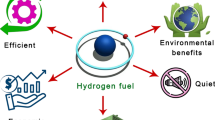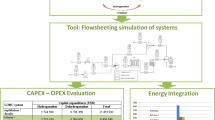Conclusions
-
1.
Treatment of the hydrocracking distillate with either an aqueous solution of fresh sulfuric acid or with the spent acid after sulfuric acid alkylation ensures that a stabilized component of diesel fuel will be obtained without changing its initial hydrocarbon composition.
-
2.
It was shown that the basic reason for the low chemical stability of the distillate from the hydrocracking of deasphaltizate is the increased concentration of nitrogen, oxygen, and sulfur compounds with an unstable structure in it. Upon their removal the distillate acquires the necessary stability.
-
3.
The nonhydrocarbon compounds which are present in the hydrocracking distillate are characterized. It was shown that they consist of nitrogen, oxygen, and sulfur compounds, mainly cyclic in nature.
Similar content being viewed by others
Literature cited
Investigation and Use of Hydrogenation Processes in Petroleum Refining and Petrochemical Industry [in Russian], TSNIITÉneftekhim (1968).
A. A. Oswald and F. Noel, Journal of Chemical and Engineering Data, Vol. 6, No. 2 (1961).
Ya. B. Chertkov, Present Day and Prospective Hydrocarbon Reagents and Diesel Fuels [in Russian], Khimiya (1968).
The Nitrogen Compounds of Petroleum (Literature Survey) [in Russian], Bash NII NP (1968).
G. F. Bol'shakov and E. A. Glebovskaya, Heteroorganic Compounds of Reactive Fuels [in Russian], Gostoptekhizdat (1962).
Ya. B. Chertkov, V. N. Zrelov, and N. A. Afanas'eva, Zh. Priklad. Khim., No. 9 (1960).
L. N. Tokareva, G. D. Gal'pern, et al., Neftekhimiya, No. 3 (1968).
Operating Properties of Reactive Fuels at Elevated Temperatures. Collection of articles edited by Professor Ya. B. Cherkov [in Russian], GOSINTI (1959).
Petroleum Products. Testing Methods [in Russian], Part I, Standartgiz (1967).
Ya. B. Chertkov, V. G. Spirkin, and V. N. Demishev, Author's Certificate 197,063, December 13, 1966; Byull. Izobret., No. 12 (1967).
Ya. B. Chertkov, V. G. Spirkin, and V. N. Demishev, Neftekhimiya, No. 5 (1965).
L. K. Ezova, V. G. Spirkin, et al., Neftepererabotka i Neftekhimiya, No. 10 (1966).
K. Élis, Chemistry of Petroleum Hydrocarbons and Their Derivatives [in Russian], Vol. 11, ONTI (1938).
R. Fuson, Reactions of Organic Compounds [Russian translation], Mir (1966), pp. 67, 98.
A. Katritskii and J. Lagovskaya, Chemistry of Heterocyclic Compounds [Russian translation], IL (1963).
T. I. Temnikova, Course in the Theoretical Fundamentals of Organic Chemistry [in Russian], Goskhimizdat (1962).
G. F. Bol'shakov, E. A. Glebovskaya, and Z. N. Kaplan, Infrared Spectra and X-Ray Diagrams for Heteroorganic Compounds [in Russian], Khimiya (1967).
E. A. Glebovskaya and G. F. Bol'shakov, Zavod. Lab., No. 2 (1963).
Author information
Authors and Affiliations
Additional information
Translated from Khimiya i Tekhnologiya Topliv i Masel, No. 2, pp. 1–4, February, 1970.
Rights and permissions
About this article
Cite this article
Éigenson, A.S., Stekhun, A.I., Sklyar, I.M. et al. Chemical stabilization of hydrocracking distillates. Chem Technol Fuels Oils 6, 79–83 (1970). https://doi.org/10.1007/BF00719407
Issue Date:
DOI: https://doi.org/10.1007/BF00719407




